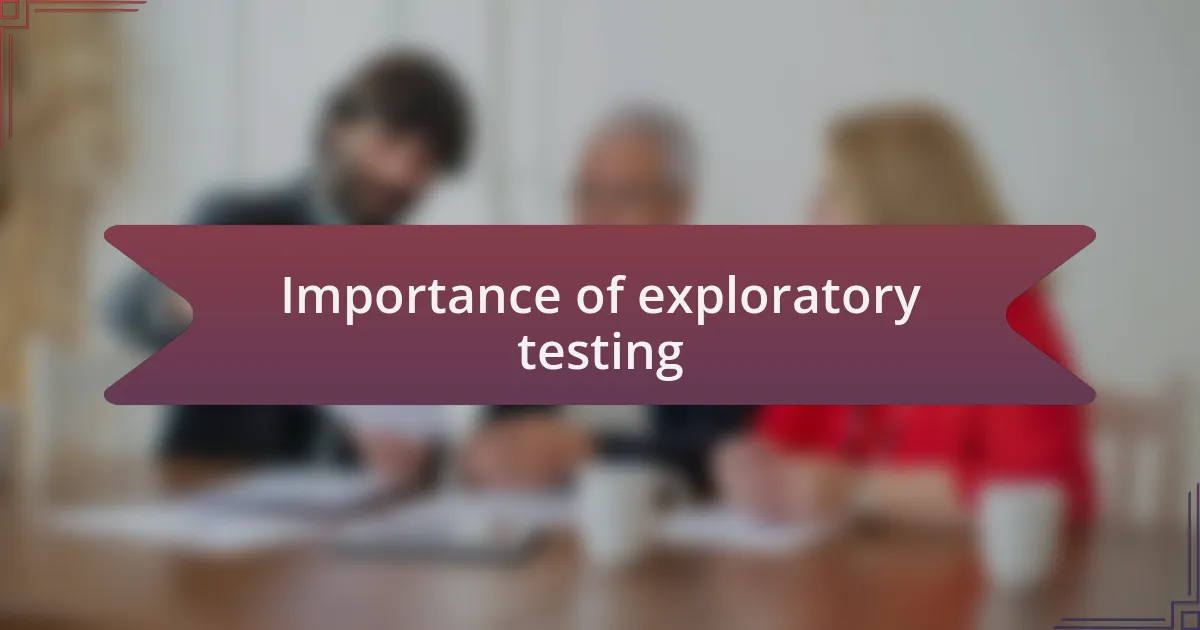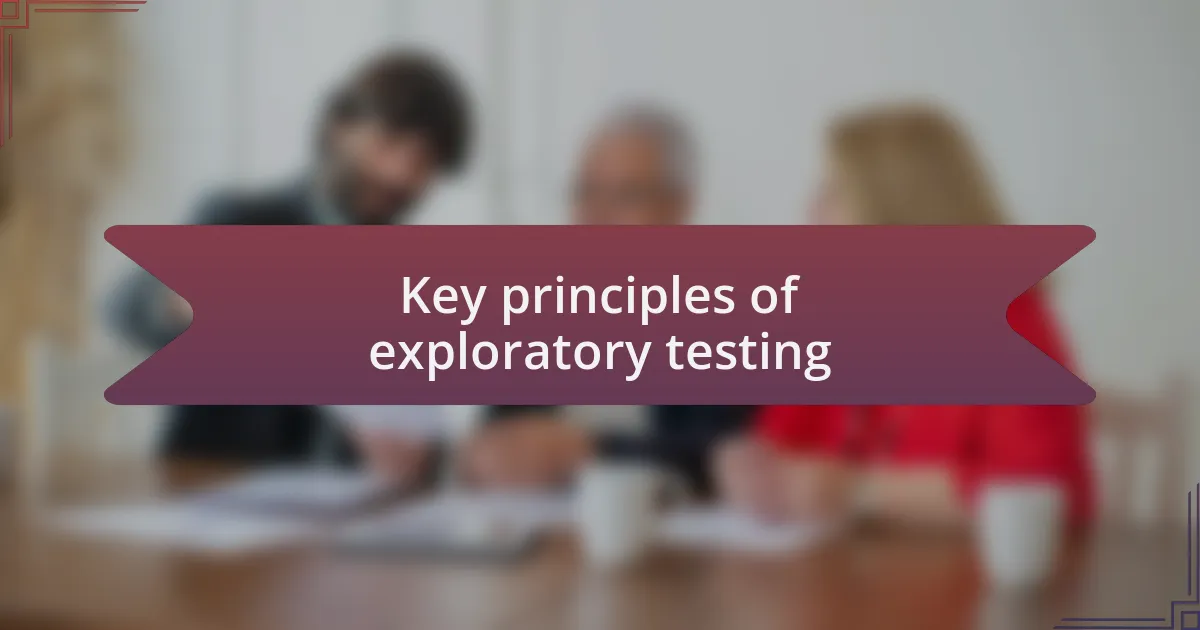Key takeaways:
- Exploratory testing emphasizes creativity and intuition, allowing testers to uncover critical issues that structured tests may miss.
- This testing approach enhances understanding of user interactions, revealing usability issues by adopting the user’s perspective.
- Documentation and timeboxing are essential practices—recording observations maintains insights, while setting time limits encourages focused exploration.
- Collaboration and sharing findings within a team lead to richer insights and strengthened testing strategies.

Understanding exploratory testing
Exploratory testing is like an adventure into the unknown realms of a software application, allowing testers to unleash their creativity and intuition. I remember a time when I was tasked with testing a complex web application without a formal test plan. Instead of following a checklist, I dove in, navigating through features with curiosity, which surprisingly revealed critical bugs that scripted tests would have missed. This experience taught me how exploratory testing emphasizes human judgment, allowing us to discover issues based on the user experience.
I’ve often felt that exploratory testing is less about adhering to strict rules and more about harnessing one’s instincts. There’s a certain thrill in trying to break things or discovering unexpected behavior, similar to solving a mystery. Have you ever wondered how a user might interact with your application in ways you never anticipated? When I approach exploratory testing, I think about all the diverse backgrounds and behaviors of potential users, which often leads to insights that not only improve the software but also deepen my understanding of user needs.
Engaging in exploratory testing requires an open mind and an analytical eye. I vividly recall a session where, while testing a newly developed feature, I stumbled upon a usability flaw that could confuse users—something I hadn’t encountered before in any documentation. This hands-on approach highlights how effective exploratory testing is for uncovering hidden gems and pitfalls alike, making it an invaluable practice in the software development lifecycle.

Importance of exploratory testing
Exploratory testing plays a crucial role in enhancing software quality by enabling testers to think outside predefined parameters. I recall a project where I found a severe performance issue that automated tests failed to catch. It made me realize how significant it is to remain flexible and adaptable in our testing approaches—this flexibility can lead to critical insights that aren’t always captured in structured test plans.
One of the most rewarding aspects of exploratory testing is that it allows for a more genuine understanding of user interaction. During one session, I unexpectedly discovered that a simple change in the user interface led to confusion among users trying to navigate the app. It struck me how essential it is to adopt the user’s perspective because, without that, we might overlook entire areas that need improvement. How often do we rely solely on technical specifications and forget the actual user experience?
It’s fascinating how exploratory testing can illuminate areas of risk in the software development process. I vividly remember feeling a sense of urgency as I realized that users might face hurdles when using a newly released feature. In those moments, I appreciate the importance of not just executing tests but truly engaging with the software, ensuring we deliver a product that genuinely meets user needs and expectations. In essence, exploratory testing is more than a technique—it’s an approach that centers on empathy and understanding in software development.

Key principles of exploratory testing
When discussing exploratory testing, one key principle that stands out is the emphasis on critical thinking and intuition. I remember a time when I was testing a new feature and had a gut feeling something wasn’t quite right. Trusting that instinct led me to uncover a significant security flaw, which automated tests had completely missed. It made me reflect on how our instincts can often guide us to areas that need attention, reminding me that as testers, we aren’t just following a checklist, but are actively engaged problem solvers.
Another essential principle is the idea of timeboxing. I often set aside specific time blocks for exploratory sessions, which keeps the focus sharp. During one of these timeboxes, I discovered a flow break in the checkout process that, while minor in the grand scheme of the application, could have easily led to lost sales. It’s a unique balance of pressure and discovery—each minute counts, yet it allows for creative exploration that structured testing simply can’t replicate.
Documentation, while often overlooked in exploratory testing, is vital. I’ve found that jotting down observations in real-time can preserve those valuable insights that might otherwise fade away. In one project, capturing unexpected user behavior during a session allowed the development team to pivot our approach entirely. How often do we lose those golden nuggets of insight? Keeping a record not only helps in refining testing strategies but also ensures that our findings can lead to meaningful discussions and improvements later on.

Tools for exploratory testing
When it comes to tools for exploratory testing, I can’t emphasize enough the value of using session-based test management systems. In my experience, tools like TestRail or SessionStack not only help organize my findings but also allow me to track the time I spend exploring different areas of the application. It’s almost like a personal dashboard that keeps me accountable as I delve into the unknown. Have you ever felt overwhelmed by what to test next? A structured approach through these tools can make all the difference.
Another tool that I’ve found immensely helpful is screen recording software. By capturing my exploratory sessions, I can review my thought process later and share insights with the team. There was a time when I stumbled upon a critical bug that was hard to replicate. Thankfully, the recording provided a visual reference that clarified my actions and led to a quicker resolution. Isn’t it fascinating how technology can enhance our testing and collaboration?
Lastly, let’s not forget the power of mind mapping tools, such as MindMeister. I often use them to brainstorm test ideas and paths before diving into a session. This visual representation of thoughts allows me to see connections and possibilities that might not be immediately apparent. Have you tried mind mapping for testing? It’s incredibly empowering to visualize a wide array of exploratory paths that can lead to valuable discoveries.

Lessons learned from exploratory testing
There’s a depth of understanding that comes from exploratory testing that textbooks seldom capture. One lesson I’ve learned is that unexpected outcomes often lead to the most valuable insights. I remember a session where I intentionally tried to break a feature by pushing it beyond its intended limits. To my surprise, I discovered a hidden vulnerability that could have jeopardized user data. Have you experienced something similar, where stepping out of conventional paths revealed critical issues?
Another vital insight is the importance of encouraging a mindset of curiosity and creativity. I’ve often found myself thinking outside the box, approaching testing from angles I wouldn’t usually consider. This not only makes the process more enjoyable but also opens doors to innovative testing scenarios. I recall a time when I decided to role-play as an end user instead of simply following the test cases. It transformed my perspective and led me to identify usability issues that enhanced the overall user experience.
Lastly, I’ve learned that collaboration amplifies the benefits of exploratory testing. Sharing insights with colleagues can spark discussions that lead to deeper discoveries. During a team debrief after an exploratory session, we uncovered overlapping findings, which ultimately strengthened our testing strategy. Isn’t it enlightening how collective experiences can weave a richer tapestry of understanding in a project?

Tips for effective exploratory testing
When it comes to effective exploratory testing, I find that setting clear objectives is vital. I make it a point to define what I want to achieve before diving in, whether it’s uncovering usability issues or performance bottlenecks. This focused approach often helps me narrow down my exploration and zero in on areas that may not be as intuitive.
Another tip I swear by is documenting my thought process as I test. After all, I want to remember what I did and why I did it. During one testing session, I began jotting down not only the steps I took but also my immediate reactions and thoughts. This practice not only facilitated discussions with my team later but also served as a personal guide for future tests. Have you ever noticed how easy it can be to forget those ‘aha’ moments if they’re not noted down?
Lastly, embracing time limits can be particularly enriching. While the freedom to explore is exhilarating, I’ve found that constraining myself to a time box fosters a sense of urgency that can unveil insights I’d otherwise overlook. On a recent project, I set a 30-minute timer to explore a new feature. The pressure pushed me to think creatively and act decisively, leading to the discovery of a significant bug that had been hiding in plain sight. Would you try a similar tactic? Sometimes, time really is of the essence.